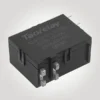What Is a Latching Relay?
Understanding how a latching relay working is key to selecting the right component for energy-saving and memory-retaining applications.
A latching relay is a type of electromagnetic switch that maintains its last state (ON or OFF) even after the control power is removed. Unlike traditional relays that require constant current to hold their position, a latching relay only needs a short pulse to change its state—making it an energy-efficient solution for many control systems.

How Does a Latching Relay Work?
The working principle of a latching relay depends on its internal structure, typically using permanent magnets or mechanical latching mechanisms to hold the relay in position after actuation. Here’s a simplified explanation:
1. Single-Coil Latching Relay Working
In a single-coil latching relay, one control pulse energizes the coil to toggle the contact state. The polarity of the pulse determines whether the relay switches ON or OFF. The position is held magnetically until the next control pulse with opposite polarity is applied.
2. Double-Coil Latching Relay Working
Double-coil designs use two separate coils—Set and Reset. A short pulse to the Set coil closes the contacts; a pulse to the Reset coil opens them. No current flows through the coil between operations, reducing power consumption.
Key Features of Latching Relay Working Mechanism
- Bistable operation: Retains ON or OFF state without continuous power.
- Pulse-driven switching: Operates with short-duration electrical pulses.
- Power-off memory: Maintains last known state during power failures.
- Mechanical or magnetic holding: Prevents unnecessary power usage.
Applications That Benefit from Latching Relay Working
The unique working principle of latching relays makes them ideal for:
- Electric meters & smart grids
Used to remotely disconnect or reconnect loads while minimizing standby energy. - Renewable energy systems
Applied in battery storage, solar inverters, and EV charging to retain circuit status during outages. - Lighting control & automation
Common in programmable lighting systems to reduce energy usage and ensure reliability. - Industrial automation
In motor control, safety interlocks, and emergency shutdowns, the latching relay working mechanism provides safe and stable operation.
Tips for Selecting a Latching Relay
When evaluating latching relays, focus on:
- Coil voltage and contact rating
- Coil type (single-coil vs dual-coil)
- Switching logic (toggle or separate set/reset)
- Size and mounting type
- Environmental durability (temperature, vibration, etc.)
Working with a trusted relay manufacturer ensures product reliability and compliance with safety standards like UL, CE, or RoHS.
Conclusion
The latching relay working principle offers a reliable and energy-saving solution for modern electrical systems. Whether in industrial control or energy management, its ability to retain state without continuous power makes it a top choice for smart design engineers. Understanding how a latching relay works helps you implement better, more efficient systems.




